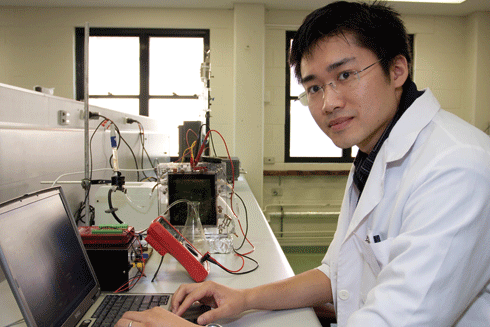
|
Published:
Murdoch’s green wastewater machine
Researchers at Murdoch University’s Faculty of Sustainable, Environmental and Life Sciences are developing cutting edge bioelectrochemical systems that turn wastewater into electricity.

|
|
Murdoch PhD student, Ka Yu Cheng, is developing a unique wastewater treatment system that harnesses electrochemical energy from microbial activity. Credit: Murdoch University
|
Bioelectrochemical systems (BESs) – which include microbial fuel cells (MFCs) and microbial electrolysis cells (MECs) – offer a new way of treating wastewater and recovering useful energy such as electrical power, without the high levels of greenhouse gas emissions produced by conventional forms of wastewater treatment and electricity generation.
Murdoch’s Professor Goen Ho, Dr Ralf Cord-Ruwisch and PhD student Ka Yu Cheng recently patented a new, more efficient BES, known as a rotatable bioelectrochemical contactor (RBEC).
Conventional rotating biological contactors (RBCs) are a type of secondary treatment process used in the treatment of wastewater following primary treatment (usually filtration and settling). A rotating shaft carrying discs with biofilms allows the wastewater to come into contact with microorganisms and provides aeration, resulting in biological degradation of the pollutants.
While RBCs have been used by the wastewater treatment industry for 30 years, the more advanced RBEC increases the efficiency of the process by more than 15 per cent.
Professor Ho says: ‘Just by doing something simple you can increase the efficiency without using any more power’.
The RBEC system works by using bacteria to catalyse either an anodic or cathodic reaction at a conductive electrode surface. The electron flow involved in this process can be directly recovered as electricity when the RBEC is operated as a MFC.
The system is also the first of its kind.
Mr Cheng says the RBEC project is truly interdisciplinary, involving not only biotechnology, but electrochemistry and material science.
With onset of the global energy and water crisis, Mr Cheng hopes to become more involved in research and development of clean technology and bioelectricity.
‘It is not possible to transform today’s use of fossil fuels overnight,’ he says. ‘It’s a long-term process that will certainly involve our future generations.
‘The most important thing is to change our mindset and think of better ways to manage our existing bioresources for renewable energy – BES is not the only solution. We should continue to keep our minds open.’
This article is republished with permission from ScienceNetwork WA, with some additional editing.
|
The idea of tapping into the electrical energy released when bacteria, algae and other microorganisms oxidise waste first came to public attention in the 1960s when NASA was looking for a way to reprocess human sewage inside a spacecraft. |
Today, bioelectrochemical systems (BESs) are being investigated more |
BESs can take the form of microbial |
MFCs produce electricity from the anaerobic oxidation of organic substrates inside the bioelectrochemical cells. Microbes in the anode compartment produce electrons and protons from the oxidation of organic matter. The electrons flow across an external electric circuit from the anode to the cathode, where the electrons react with the protons and oxygen to form water. |
Useful applications of MFCs include decentralised sewage treatment plants in remote areas, sediment-based electrical power generation and bioremediation. |
While BESs could enable electricity and other products to be generated with lower greenhouse gas emission rates compared to conventional technologies, researchers still face the challenge of improving the energy capture rate of today’s systems. |
Murdoch University (see main story) has submitted a patent application aimed at improving the efficiency of MFCs. |
More information:
Dr Ralf Cord-Ruwisch, R.Cord-Ruwisch@murdoch.edu.au
Ka Yu Cheng, K.Cheng@murdoch.edu.au
Professor Goen Ho, G.Ho@murdoch.edu.au



